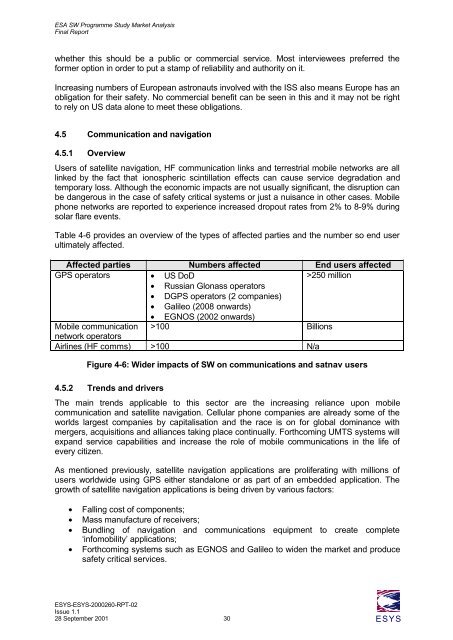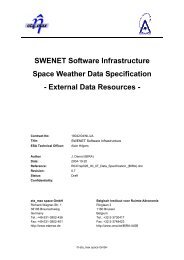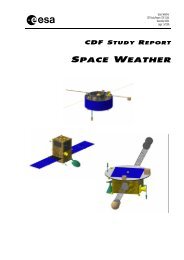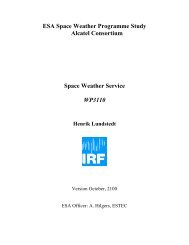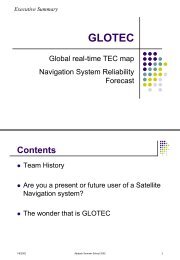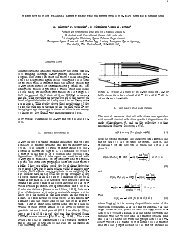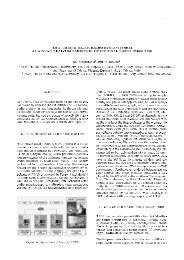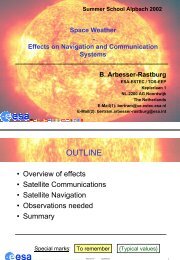market analysis final report v1.1 - ESA Space Weather Web Server
market analysis final report v1.1 - ESA Space Weather Web Server
market analysis final report v1.1 - ESA Space Weather Web Server
You also want an ePaper? Increase the reach of your titles
YUMPU automatically turns print PDFs into web optimized ePapers that Google loves.
<strong>ESA</strong> SW Programme Study Market Analysis<br />
Final Report<br />
whether this should be a public or commercial service. Most interviewees preferred the<br />
former option in order to put a stamp of reliability and authority on it.<br />
Increasing numbers of European astronauts involved with the ISS also means Europe has an<br />
obligation for their safety. No commercial benefit can be seen in this and it may not be right<br />
to rely on US data alone to meet these obligations.<br />
4.5 Communication and navigation<br />
4.5.1 Overview<br />
Users of satellite navigation, HF communication links and terrestrial mobile networks are all<br />
linked by the fact that ionospheric scintillation effects can cause service degradation and<br />
temporary loss. Although the economic impacts are not usually significant, the disruption can<br />
be dangerous in the case of safety critical systems or just a nuisance in other cases. Mobile<br />
phone networks are <strong>report</strong>ed to experience increased dropout rates from 2% to 8-9% during<br />
solar flare events.<br />
Table 4-6 provides an overview of the types of affected parties and the number so end user<br />
ultimately affected.<br />
Affected parties Numbers affected End users affected<br />
GPS operators • US DoD<br />
>250 million<br />
• Russian Glonass operators<br />
• DGPS operators (2 companies)<br />
• Galileo (2008 onwards)<br />
• EGNOS (2002 onwards)<br />
Mobile communication<br />
network operators<br />
>100 Billions<br />
Airlines (HF comms) >100 N/a<br />
Figure 4-6: Wider impacts of SW on communications and satnav users<br />
4.5.2 Trends and drivers<br />
The main trends applicable to this sector are the increasing reliance upon mobile<br />
communication and satellite navigation. Cellular phone companies are already some of the<br />
worlds largest companies by capitalisation and the race is on for global dominance with<br />
mergers, acquisitions and alliances taking place continually. Forthcoming UMTS systems will<br />
expand service capabilities and increase the role of mobile communications in the life of<br />
every citizen.<br />
As mentioned previously, satellite navigation applications are proliferating with millions of<br />
users worldwide using GPS either standalone or as part of an embedded application. The<br />
growth of satellite navigation applications is being driven by various factors:<br />
• Falling cost of components;<br />
• Mass manufacture of receivers;<br />
• Bundling of navigation and communications equipment to create complete<br />
‘infomobility’ applications;<br />
• Forthcoming systems such as EGNOS and Galileo to widen the <strong>market</strong> and produce<br />
safety critical services.<br />
ESYS-ESYS-2000260-RPT-02<br />
Issue 1.1<br />
28 September 2001 30 ESYS


